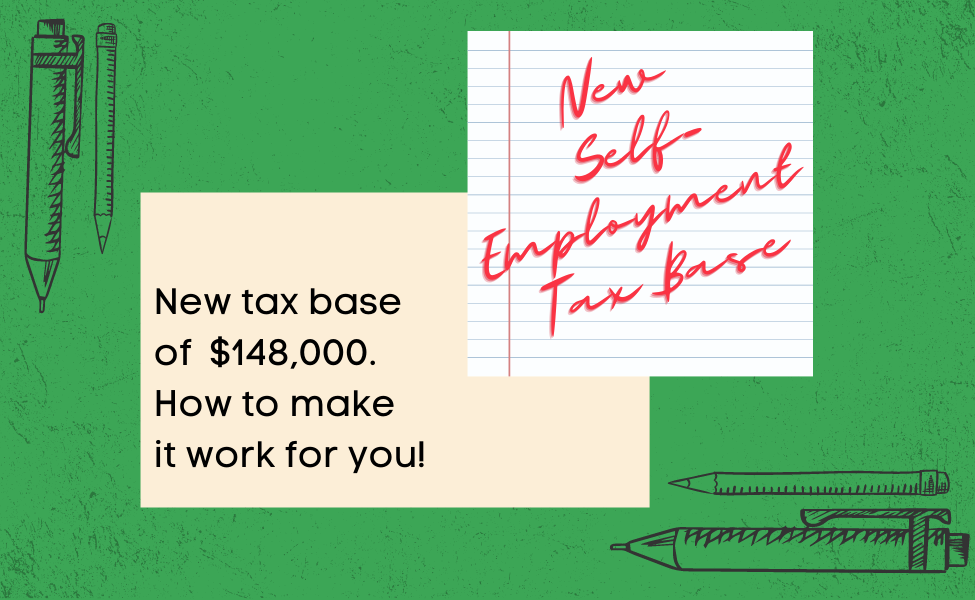New Self Employment Tax Base and How to Make it work for you!

What happens when lawmakers enact a new tax? Usually its so complicated and confusing no one an understand it, Mostly, It is usually a bad thing, specifically if you are self-employed. This article will explain the new law and more importantly, how to make it work for you!
The of self-employment tax
I promise it is not as boring as it sounds!
It starts small. It looks easy. But you know that isn’t really the case! As more and more workers become self-employed either by voice to strike out on their own, or your company has switched you over to a 1099 to save money on their own payroll taxes. More and more Americans are working on their own.
In 1935, the self-employment tax topped out at $60. That’s right, about your monthly budget for your favorite shop. Those 1935 lawmakers must be twisting in their graves with the new rules for 2021, which levy the following taxes:
- 15.3% tax on self-employment income up to $142,800. That is up to $21,848.
- With an additional 2.9% tax that applies to all self-employment income in excess of the base amount.
What started out as a small tax on the self employed has become an unimaginable amount, even with taking inflation into account!

Look at what has happened to self-employment taxes since they first came into being in 1935, assuming you earn at the base amount:
- $60 in 1935
- $60 in 1949
- $3,175 in 1980
- $7,849 in 1990
- $14,413 in 2006
- $21,848 in 2021
Tax Hit
To put the rates in perspective, say you are single and earn $150,000. On the last dollar you earned—dollar number $150,000—how much federal tax did you pay?
The answer is two fold- 14 cents in self employment and 24 cents in federal income taxes- totaling $0.39. It’s ok I’ll wait while you pick your jaw up from the floor.
Now if you live in a state with an income tax, add the state income tax on top of that.
 How to plan for this tax onslaught
How to plan for this tax onslaught
- Your new deductions give you benefits starting at your highest tax rates.
- In most cases, returns on tax planning are not a one-time event. Once your plan is in place, you reap the benefits year after year.
Checklist
Here is a short checklist of some tax-planning ideas. Review these ideas so you can identify new business deductions for your tax return. You want business deductions because business deductions reduce both your income and your self-employment taxes.

- Eliminate the word “friend” from your vocabulary. From now on, these people are sources of business, so start talking business and asking for referrals over meals and beverages.
-
Hire your children. This creates tax deductions for you, and it creates non-taxable or very low taxed income for the children. Also, wages paid by parents to children are exempt from payroll taxes.
-
Learn how to combine business and personal trips so that the personal side of your trip becomes part of your business deduction under the travel rules (for example, traveling by cruise ship to a convention on St. Thomas).
-
Properly classify business expansion expenses as immediate tax deductions rather than depreciable, amortizable, or (ouch!) non-deductible capital costs.
-
Identify deductible start-up expenses ($5,000 up-front and the balance amortized) rather than letting them fall by the wayside (a common oversight).
-
Correctly classify business meals that qualify for the 100 percent deduction rather than the 50 percent deduction. (see previous article on this matter for details. See our Article How to get Deduct 100% of Your Employee Recreation and Parties for more information.
-
Know the entertainment facility rules so your vacation home can become a tax deduction.
-
Identify the vehicle deduction method that gives you the best deductions (choosing between the IRS mileage method and the actual expense method).

-
Your maximum business miles, so you deduct the largest possible percentage of your vehicles.
-
Qualify your in your home as an administrative . See our article Your Home : Using partial, whole or multiple rooms for more information.
-
Use allocation methods that make your home- deductions larger.
-
If you are married with no employees, hire your spouse and install a Section 105 medical plan to move your medical deductions to Schedule C for maximum benefits. See our article 5 Things to know about Employing your Spouse
-
Operate as a one-person S corporation to save self-employment taxes.
-
If you are single with no employees, operate as a C corporation and install a Section 105 medical plan so you can deduct all your medical expenses.
If you are unsure if your company is meeting its full tax saving benefit, sign up for one of our business consultation appointment.



